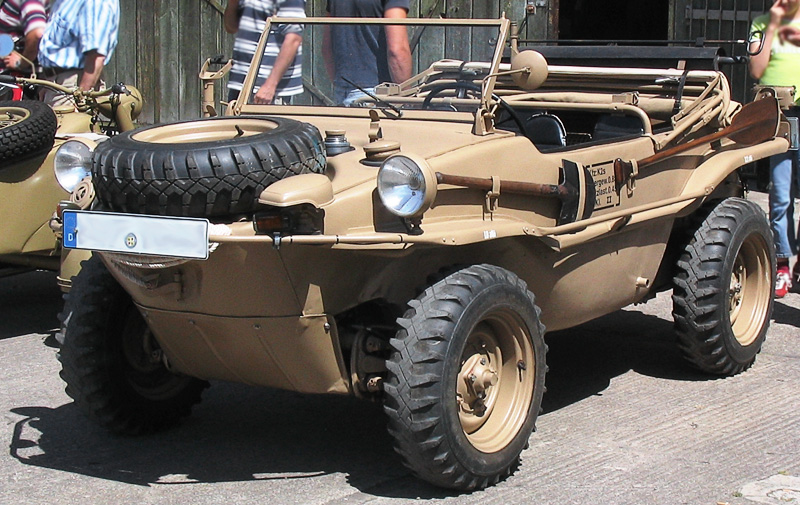To my unit do I need some reconnaissance platoon and for the Stug company do I only have one option which is the Sturm Reconnaissance platoon. The platoon is in base 5 Motorcycle mg teams which you can swap to Schwimmwagens for no cost. There where some confusion regarding the basing and the rules for this new teams because they have introduced the same rules as in Blitzkreig and Hellfire and Back books for EW.
The new rules are saying that my teams are "reconnaissance" teams while there mounted. They can demount send the bikes/jeeps away and become normal soldiers and later in the game call for the bikes/jeeps again and mount again. The really good thing with the new rules are that they have a 3+ save even when they are mounted. When you use this new kind of rec team is the basing change. You should use the EW way of basing which is a medium base for the command team and a large bases for you MG teams.
More information regarding Schwimmwagen
Volkswagen Schwimmwagen
From Wikipedia, the free encyclopedia
 | |
| Manufacturer | Volkswagen |
|---|---|
| Production | 15,000 (1942-1944) |
| Engine | 4-cyl. boxer, air cooled 1,131 cc, 25 hp @ 3,000 rpm |
| Transmission | 4-speed manual 2-speed transfer case; 4WD only on 1st gear / reverse |
| Wheelbase | 200 cm (78.7 in) |
| Length | 382.5 cm (150.6 in) |
| Width | 148 cm (58.3 in) |
| Height | 161.5 cm (63.6 in) |
| Curb weight | 910 kg (1,345 kg GVW) |
| Related | VW type 86 & 87 |
The VW Type 128 and 166 Schwimmwagen (literally Floating / Swimming Car) were amphibious four-wheel drive off-roaders, used extensively by the German Wehrmacht and the Waffen-SS during the Second World War. The Type 166 is the most numerous mass-produced amphibious car in history.
Contents[hide] |
[edit]Development
Volkswagen Schwimmwagens used the engine and mechanicals of the VW Type 86 four-wheel drive prototype of theKübelwagen and the Type 87 four-wheel drive 'Kübel/Beetle' Command Car, which in turn were based on the platform of the civilian Volkswagen Beetle. Erwin Komenda, Ferdinand Porsche's first car body designer, was forced to develop an all-new unitized bodytub structure since the flat floorpan chassis of the existing VW vehicles was unsuited to smooth movement through water. Komenda patented his ideas for the swimming car at the German Patent office.
The earliest Type 128 prototype was based on the full-length Kübelwagen chassis with a 240 cm (7.9 ft) wheelbase. Pre-production units of the 128, fitted with custom welded bodytubs, demonstrated that this construction was too weak for tough off-roading, had insufficient torsional rigidity, and easily suffered hull-ruptures at the front cross-member, as well as in the wheel-wells. This was unacceptable for an amphibious vehicle. The large-scale production models (Type 166) were therefore made smaller, and had a wheel-base of only 200 cm (6.6 ft).
VW Schwimmwagens were both produced by the Volkswagen factory at Fallersleben / Wolfsburg, as well as by Porsche's facilities in Stuttgart; with the bodies (or rather hulls) produced by Ambi Budd in Berlin. From 1941 through 1944 a total of 15,584 Type 166 Schwimmwagen cars were produced; 14,276 at Fallersleben and 1,308 by Porsche. Given these numbers, the VW 166 is the most mass-produced amphibious car in history.[citation needed] Only 163 are known by the Schwimmwagen Registry to remain today, and only 13 have survived without restoration work.[1]
[edit]Technology
All Schwimmwagen were four wheel drive only on first gear (and reverse gears with some models) and had ZF self-locking differentials on both front and rear axles. Just like the Kübelwagen, the Schwimmwagen had portal gear rear hubs that gave better ground clearance, while at the same time reducing drive-line torque stresses with their gear reduction at the wheels.
When crossing water a screw propeller could be lowered down from the rear deck engine cover. When in place a simple coupling provided drive straight from an extension of the engine's crankshaft. This meant that screw propulsion was only available going forward. For reversing in the water there was the choice of using the standard equipment paddle or running the land drive in reverse, allowing the wheel-rotation to slowly take the vehicle back. The front wheels doubled up as rudders, so steering was done with the steering wheel both on land and on water.


No comments:
Post a Comment